Learning Activity 1- Tone and Mood
The first element of my poetry unit looked at tone and mood. I posted the definitions of tone and mood to differentiate the two, and handed out 3 different poems, all written by Elizabeth Acevedo, the author of the unit’s central text. I read the first poem aloud, identified lines that stood out to me, discussed the pacing of the poem and the diction, and then identified tone and mood using the lesson’s guiding questions: How does the speaker of the poem feel? How does the poem make the reader feel? Afterwards, students took turns reading the next poem aloud, stanza by stanza, and as a whole class we discussed the same questions and identified the tone and mood. Then, students split into pairs and did the same thing for the final poem.
Learning Activity 2- Found Poetry Project
For their first attempt at putting a poem together, students worked on a found poetry project. Students picked out lines from various poems we read and used them to create a poem that responded to one of 3 prompts and outlines I provided them with. In addition to submitting the poem, they had to submit a brief analysis of its tone and mood.
Learning Activity 3- HOT Questions
A goal of mine for this unit was to amp up the amount of discourse we were having in class, and shift to conversations that were less dependent on me posing questions and facilitating discussion. I provided students with a chart that would help them create Higher Order Thinking (or HOT) questions. There were 3 levels of questions, and for each level I provided sentence stems and examples. Students worked in small groups to come up with at least one question per level that pertained to The Poet X.
Learning Activity 4- Fishbowl
The week after we finished The Poet X, I assigned a Fishbowl seminar. Students were split into an outer circle and an inner circle. The inner circle would discuss while the outer circle silently observed. I projected 5 questions that I selected from the HOT Questions activity, and told the inner circle that they should try and spend as much time on the first question as they could, and to use the rest of the questions for back up if they run out of momentum in their conversation. The inner circle discussed for twelve minutes, sometimes more without any teacher facilitation. They were responsible for the pace of the conversation and making sure everyone’s voices were heard. After the inner circle finished their discussion, the outer circle was invited to contribute comments they wanted to at the time but were not permitted to, as well as comment on the quality of the conversation and what went well. Every student got one turn in each circle. Afterwards, all students filled out a reflection examining what they did well, and what they would improve upon for next time. This activity was really intimidating to students when I first assigned it, but students did really well with it and told me afterwards that it was nowhere near as bad as they thought it would be, and a lot of students really enjoyed it. The assignment with further details can be found here.
Learning Activity 5- Poetry Project
The summative assessment of this unit was a poetry project that followed the same structure as the Found Poetry Project but with higher expectations. This time around, students were writing their own poems and were required to use multiple forms of figurative language that they had learned throughout the unit. They submitted two poems, an analysis highlighting the poetic devices used and the tone and mood of the poems. Students really enjoyed this project, and performed a poem for the class at the very end of the unit, providing praise on a collaborative Padlet page. The students loved to cheer each other on, and it was a really fun and heartwarming way to end the unit.
